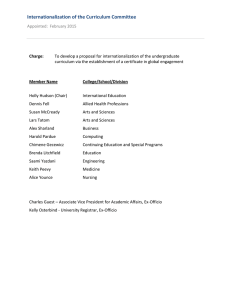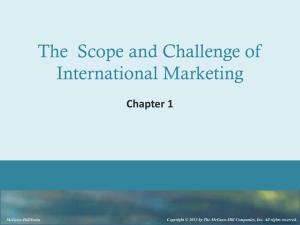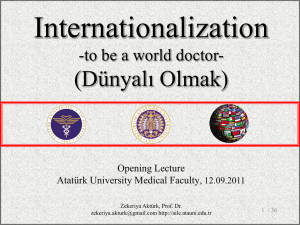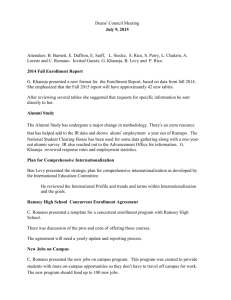Role of Campus Leadership in Managing Change and Challenges of
advertisement
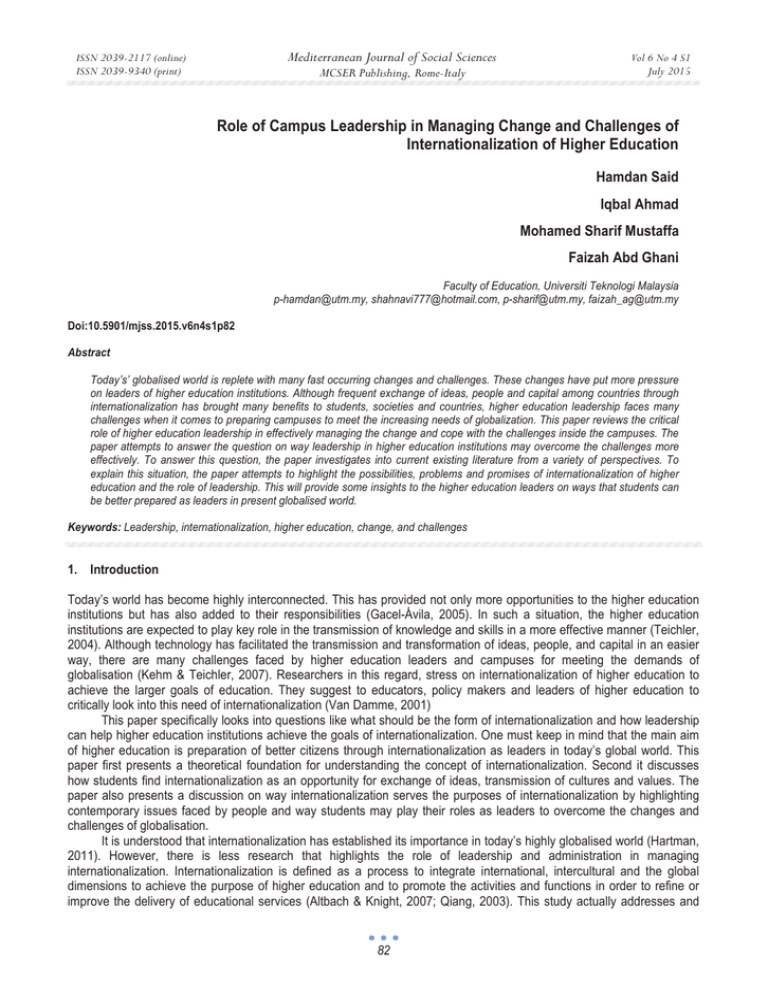
Mediterranean Journal of Social Sciences ISSN 2039-2117 (online) ISSN 2039-9340 (print) MCSER Publishing, Rome-Italy Vol 6 No 4 S1 July 2015 Role of Campus Leadership in Managing Change and Challenges of Internationalization of Higher Education Hamdan Said Iqbal Ahmad Mohamed Sharif Mustaffa Faizah Abd Ghani Faculty of Education, Universiti Teknologi Malaysia p-hamdan@utm.my, shahnavi777@hotmail.com, p-sharif@utm.my, faizah_ag@utm.my Doi:10.5901/mjss.2015.v6n4s1p82 Abstract Today’s’ globalised world is replete with many fast occurring changes and challenges. These changes have put more pressure on leaders of higher education institutions. Although frequent exchange of ideas, people and capital among countries through internationalization has brought many benefits to students, societies and countries, higher education leadership faces many challenges when it comes to preparing campuses to meet the increasing needs of globalization. This paper reviews the critical role of higher education leadership in effectively managing the change and cope with the challenges inside the campuses. The paper attempts to answer the question on way leadership in higher education institutions may overcome the challenges more effectively. To answer this question, the paper investigates into current existing literature from a variety of perspectives. To explain this situation, the paper attempts to highlight the possibilities, problems and promises of internationalization of higher education and the role of leadership. This will provide some insights to the higher education leaders on ways that students can be better prepared as leaders in present globalised world. Keywords: Leadership, internationalization, higher education, change, and challenges 1. Introduction Today’s world has become highly interconnected. This has provided not only more opportunities to the higher education institutions but has also added to their responsibilities (Gacel-Ávila, 2005). In such a situation, the higher education institutions are expected to play key role in the transmission of knowledge and skills in a more effective manner (Teichler, 2004). Although technology has facilitated the transmission and transformation of ideas, people, and capital in an easier way, there are many challenges faced by higher education leaders and campuses for meeting the demands of globalisation (Kehm & Teichler, 2007). Researchers in this regard, stress on internationalization of higher education to achieve the larger goals of education. They suggest to educators, policy makers and leaders of higher education to critically look into this need of internationalization (Van Damme, 2001) This paper specifically looks into questions like what should be the form of internationalization and how leadership can help higher education institutions achieve the goals of internationalization. One must keep in mind that the main aim of higher education is preparation of better citizens through internationalization as leaders in today’s global world. This paper first presents a theoretical foundation for understanding the concept of internationalization. Second it discusses how students find internationalization as an opportunity for exchange of ideas, transmission of cultures and values. The paper also presents a discussion on way internationalization serves the purposes of internationalization by highlighting contemporary issues faced by people and way students may play their roles as leaders to overcome the changes and challenges of globalisation. It is understood that internationalization has established its importance in today’s highly globalised world (Hartman, 2011). However, there is less research that highlights the role of leadership and administration in managing internationalization. Internationalization is defined as a process to integrate international, intercultural and the global dimensions to achieve the purpose of higher education and to promote the activities and functions in order to refine or improve the delivery of educational services (Altbach & Knight, 2007; Qiang, 2003). This study actually addresses and 82 ISSN 2039-2117 (online) ISSN 2039-9340 (print) Mediterranean Journal of Social Sciences MCSER Publishing, Rome-Italy Vol 6 No 4 S1 July 2015 examines the pursuit of the internationalization of higher education and the role of leadership in promoting it. 2. Purpose of the Review This paper has three aims. These aims are to review the role of leadership in managing changes and challenges of internationalization of higher education; to review ways leaders develop strategic plans to attain the goals of internationalization; and to review the focus, struggles, approaches, and successes of higher education institutions in promotion of internationalization. Overall this review paper provides an additional knowledge concerning the process of internationalization of higher education vis a vis the role of leadership. 2.1 Why internationalization? The world is shrinking. As a result, there are wider talks of internationalization, its importance, changes and challenges (Knight, 2004). Around the world, the needs of local communities are being connected with international communities through media and technology. This trend has created many challenges to higher education institutions and their survival as educational industries (Stohl, 2007). There is a tough competition as well. This trend has further intensified the need for internationalization of higher education (Hser, 2005). Therefore, education is now being rapidly internationalized which cannot be overlooked or ignored by any university or college that competes to become a global educational arena for preparing students to functions across the national borders (Childress, 2009). From different perspectives, it is believed that the world is shrinking. It has created challenges for the international community to plan for the common future (Harari, 1992). This thinking has also raised many questions upon the roles and responsibilities of campuses and campus leaders that whether they are preparing such individuals who have the required skills to deal with the problems of global communities (Brustein, 2007). This paper investigates into this area that how can campus leaders help to answer the risk for the future calls for reforming the higher education to meet the needs of internationalization. It is believed that the campus leaders can play a key role in enabling the campuses to avoid the risks and ensuring more cohesive approaches for the implementation of internationalization (Dewey & Duff, 2009). 2.2 Internationalization and its dynamics Internationalization is a process of change. This change occurs culturally, educationally and socially in all domains of education (Kreber, 2009). There are different ways in which leaders at higher education level may bring out this desired change for successful implementation of internationalization process within higher education institutions (Stohl, 2007). The theorists of change view the changes within organisations as dynamic, non-linear and organic. They further argue that the process of change is slow and progressive instead of instant and fast. It is a natural process which is sometimes difficult for managers and leaders to anticipate or direct. But some writers view change a deliberate process and mandatory to cope with the challenges of time (Childress, 2009). It is believed that for change management, the institutional leaders must determine what desired outcomes are required for the higher educational institutions in terms of student development. Researchers have discussed different models and outcomes about change management at higher education level especially with regard to internationalization. For this purpose, it is necessary that institutional leaders must envision the desired changes to be effected on the campus and then prepare to bring about the changes (Horta, 2009; Huang, 2007). For achieving the goals of internationalization, there is a need of effective leadership to bring about campus wide changes (Kishun, 2007). Writers believe that successful internationalization is dependent on directing the campus activities successfully. In this regard, effective institutional leadership is emphasized. The other important factor is organizational structure. There must be an institutional lead unit for facilitating and administering the affairs related to internationalization (Bennell & Pearce, 1998). Others believe that leaders may use the different resources in higher education institutions for successful implementation of internationalization process. Another vital portion of internationalization is faculty development. It is believed that if campuses are to be internationalized, it is necessary that development of faculty be prioritised by the leadership of the higher education (Taylor, 2004). There are concerns raised that faculty members are normally found ill prepared to infuse and implement the curriculum to achieve the goals and objectives of internationalization. For this purpose, researchers have proposed many solutions (Altbach & Knight, 2007; Knight, 2007): 1. There must be some initiatives for providing the faculty members with international teaching and research experience. 83 ISSN 2039-2117 (online) ISSN 2039-9340 (print) Mediterranean Journal of Social Sciences MCSER Publishing, Rome-Italy Vol 6 No 4 S1 July 2015 2. There should be some professional development opportunities provided to the faculty members in areas related to international concerns. 3. There should also be a procedure for the tenure and promotion of incentives for the faculty members to enhance their motivation. Interestingly it is believed that relatively little attention has been paid to the strategies to bring about the change, whereas, there is a need to bring about wider changes to promote quality internationalization (Devos, 2003). This will help in understanding the benefits and implications of internationalization within the broader concept of overall organizational change. There is a rich literature on organizational change and its importance for successful internationalization and developing courses which cater to international needs and that ultimately achieve the goals of global interdependency (Allen & Ogilvie, 2004). On the other hand, it has been noticed that the internationalization experts have shared little on organizational culture and the role of institutional leadership. Writers maintain that institutions increasingly value the diverse cultures and societies and integrate all these in the curriculum to harmonize internationalization (Cudmore, 2005; Kehm & Teichler, 2007). There are many different conceptualizations of organizational change in the context of internationalization. Writers believe that it is important for institutional leaders to understand the perspective of organizational development from internationalization point of view. For this purpose, positivistic approach is recommended for developing and streamlining human resources within organisations. It is assumed that leaders must assume the changes and direct their organisations toward greater effectiveness regarding achieving the goals of internationalization (Guo & Chase, 2011). The second important area for leaders to understand is strategic choice. This is related to the decisions and choices made by the organizational leaders in the context of the organizations, its specific characteristics and its environment. The third important perspective is the resource dependency within an organization (Edwards, 2007). The scope of resources basically determines the level of quality of the internationalization activities. The fourth and important perspective is population ecology in which organizational change is considered as a function of different environmental forces that affect the process of internationalization. These perspectives help organizational leaders to understand the process of change in higher educational institutions related to institutionalization of internationalization (Kerr, 1990). There are many factors that affect the leadership role in successful institutionalization of the internationalization of higher educational institutions. 2.3 Role of leaders in organizational development through managing change Internationalization of higher education plays a key role in disseminating knowledge and skills beyond the borders (Haigh, 2008). The internationalists believe that for organizational development it is necessary to focus on quality organizational change. Organizational change provides the rationale to develop overall process of internationalization. For this purpose, organizational leaders must focus on effective management of human resources. There are many factors which affect the process of organizational change and internationalization such as strategic choice, resource dependency and population change (Nilsson, 2003; James Taylor & Machado, 2006). To understand the change perspective, there is a need to identify different approaches that actually emphasise the managerial role within an organization. The campus leaders are expected to lead the process of change and internationalization effectively (Lo, 2009). Researchers assume that leaders should do more that preparing organisations to adapt to the external and internal changes which are sometimes beyond the control of the organisations. It is also believed that campus leaders so far have not been able to grapple with the changes and challenges of internationalization more effectively (Stensaker, Frølich, Gornitzka, & Maassen, 2008). There are some external factors which might affect quality internationalization at higher education level. For example, one of the factors is related to the inconsistency between institutional capacity to absorb change and goals of internationalization. Writers maintain that internationalization of higher education is essential if the students are required to be prepared for an international market and environment which goes beyond the national borders (Eikin, Farnsworth, & Tempier, 2008). There is a new shift taking place regarding internationalization. This is the environment within institutions that are changing rapidly. There is a slogan that institutions must change as the world is changing and is growing much closer to each other (Knight, 2008). The changes in the world are also influencing the organisations which are one of the challenges for the organizational leaders to cope with in future and in the present time (Guruz, 2011). Therefore, it is necessary that leaders and faculty members must realize the need to understand the nature of change and challenges faced by colleges and universities. Thus, they should in turn provide wider opportunities to students and prepare them for a shrinking world environment which is characterized by knowledge, skills and competition (Taylor, 2010). There is a need on the part of the leaders of higher education to target the future efforts for the successful 84 ISSN 2039-2117 (online) ISSN 2039-9340 (print) Mediterranean Journal of Social Sciences MCSER Publishing, Rome-Italy Vol 6 No 4 S1 July 2015 implementation of the internationalization process through reflection on the approaches to change (MillerǦIdriss & Hanauer, 2011). They should be able to foresee that what type of efforts would be needed to manage internationalization in the coming decade rather than merely looking at the present. They should also identify their resources and root causes of the problems faced by the higher education related to internationalization (Yang, 2002). Hence, many writers have suggested that the different strategies such as resource mobilization, cooperative ventures, knowledge sharing, scholarships, competitions, student and staff exchange and so on. It is believed that these might help leaders of the higher education institutions to promote the process of international successfully (Callan, 2000). It is must be remembered that internationalization is an essential part of academic life of an educational institution (Welch, 2010). The international institutions find themselves in state of pressure and flux due to internationalization in terms of exchange, research, student and faculty mobilization, and population change and most importantly, the curriculum implementation that prepares students for their future functions in an increasingly diverse international environment. Writers have presented the following recommendations for leaders at higher education level to direct and manage the process of internationalization more effectively (Childress, 2010). 1. To anticipating alternative sources for internationalization 2. To analyse the existing resources and strengths 3. To examine the critical need in the local community 4. To emphasise organizational functions rather than structures Researchers believe that an alternative educational source is a better strategy that campus leaders must focus and prioritize (Parsons & Fidler, 2005). For this purpose, one of the alternatives is to look outside of the institution for determining the sources of information and development by using technology as a source of potential international information. Campus leaders must use this source and acknowledge it. Another alternative is the different numbers of agencies and organisations that provide international education (Eikin, et al., 2008). There are agencies like Peace Corps outside of higher education which have strong record of providing relevant information regarding preparation of people for functioning in the international environment (Kreber, 2009). These agencies basically provide college students significant international education by providing them opportunities for wider interaction and diversity using internationalism as a source (Rivers, 2010). In this respect, two of the perspectives: education ecology and resource-dependency encourages academic leaders at higher education level to work for the development of students and success of international education. These agencies serve as resource centres for campus activities. They provide resources in the form of instructional support and practical experiences such as internships and so on for students. It is suggested that institutional leaders may play a key role in this respect by developing meaningful connection between higher education organisations and local communities (Chan & Dimmock, 2008). Any change with respect to internationalization of higher education must be understood from various dimensions as it is a multi-perspective affair. So leaders of the higher education should realize and consider the changes little building blocks for cementing the efforts of internationalization in an ever increasingly changing national and international scenario. This is true that no institution alone can meet its resources alone (Johnstone, d'Ambrosio, & Yakoboski, 2010). There is always a need for partnership and collaboration for realizing the goals of internationalization. For this purpose, leaders should analyse the strengths and weaknesses of the higher educational institutions and build upon the strengths and minimize the weaknesses (Pandit, 2009). Today, campus leaders need to develop existing resources rather than starting new brand programmes. This will help in smoothly running the existing programmes that will add to the quality of the programmes (Foskett, 2010). Indeed, for changing the international education through internationalization there is a need that the higher institutions must focus on developing closer links with the communities. This linkage will promote trust and commitment between local and international communities and higher education which is one of the essential requirements for successful internationalization (Hénard, Diamond, & Roseveare, 2012). For successfully promoting students internationally, campus leaders must take a local look at the sources available to them. This localization will help leaders better prepare the institutions for functioning in the international arena (Chin & Ching, 2009). Leaders must try to answer the following key questions which are attached with the process of internationalization of education such as, do business need assistance with foreign languages? Does the current job market looking for such expertise that could help implement export and import successfully? Does the immigrant population need special skills? It is believed that the university that effectively position itself for meeting these local community needs will possess more chances or likelihood to contribute comprehensively to the endeavours of internationalization (Crose, 2011). When the higher education institutions seriously attempt to develop projects, programmes and courses that meet the needs of students, faculty alike also create strong international skills for enhancing their productivity and marketability 85 ISSN 2039-2117 (online) ISSN 2039-9340 (print) Mediterranean Journal of Social Sciences MCSER Publishing, Rome-Italy Vol 6 No 4 S1 July 2015 (Ping, 1999). It has been observed that in successful international institutions, campus leaders often turn to create an international office for internationalizing their institutions (Brown & Jones, 2007). However, for successfully running the international office, it is always assumed that the organizational structure provides full support to enhance the institution’s ability to deal with the change and challenges of internationalization. It is far more important that the leaders must become involve in the promotion of the international functions and capacity of the college or university (Jones & Oleksiyenko, 2011). 3. Conclusion The internationalization is a multidimensional concept. It is necessary that the international office of the university must realize the complexity and concerns of the internationalization process. There is a need to organise and promote new programmes, plans and initiatives. In this regard, the role of international leaders is too broad and comprehensive. It is suggested that to achieve the true goals of internationalization, the campus must try to promote and develop all types of internationalization efforts, encourage the developments of collecting international expertise from different sources, developing links with international institutions and promoting experience sharing environment within the campus. It is a reality that internationalization is nothing but geographical expansion of the university to international borders from localization of education to internationalization involving the world as a community. Hence, the paper concludes that effective internationalization is more than merely developing international programmes. It is developing programmes that help expand the geographical and academic borders of the university and the sphere of its functions and influence beyond borders. This kind of developments becomes truly possible when it is handled carefully, with commitment and innovation so that the process of internationalization is understood along with its disciplinary and professional needs to meet the needs of both national and international community. References Allen, M., & Ogilvie, L. (2004). Internationalization of higher education: potentials and pitfalls for nursing education. International Nursing Review, 51(2), 73-80. Altbach, P. G., & Knight, J. (2007). The internationalization of higher education: Motivations and realities. Journal of Studies in International Education, 11(3-4), 290-305. Bennell, P., & Pearce, T. (1998). The internationalization of higher education: Exporting education to developing and transitional economies. International Journal of Educational Development, 23(2), 215-232. Brown, S., & Jones, E. (2007). Internationalising higher education. London: Routledge. Brustein, W. I. (2007). The global campus: Challenges and opportunities for higher education in North America. Journal of Studies in International Education, 11(3-4), 382-391. Callan, H. (2000). Higher education internationalization strategies: Of marginal significance or all pervasive? The international vision in practice: A decade of evolution. Higher Education in Europe, 25(1), 15-23. Chan, W. W., & Dimmock, C. (2008). The internationalization of universities: Globalist, internationalist and translocalist models. Journal of Research in International Education, 7(2), 184-204. Childress, L. K. (2009). Internationalization plans for higher education institutions. Journal of Studies in International Education, 13(3), 289-309. Childress, L. K. (2010). The twenty-first century university: Developing faculty engagement in internationalization: New York, NY: Peter Lang. Chin, J. M. C., & Ching, G. S. (2009). Trends and indicators of Taiwan's higher education internationalization. The Asia-Pacific Education Researcher, 18(2), 185-203. Crose, B. (2011). Internationalization of the higher education classroom: Strategies to facilitate intercultural learning and academic success. International Journal of Teaching and Learning in Higher Education, 23(3), 388-395. Cudmore, G. (2005). Globalization, internationalization, and the recruitment of international students in higher education, and in the Ontario Colleges of Applied Arts and Technology. Canadian Journal of Higher Education, 35(1), 37-60. Devos, A. (2003). Academic standards, internationalization, and the discursive construction of" the international student". Higher Education Research and Development, 22(2), 155-166. Dewey, P., & Duff, S. (2009). Reason before passion: Faculty views on internationalization in higher education. Higher education, 58(4), 491-504. Edwards, J. (2007). Challenges and opportunities for the internationalization of higher education in the coming decade: Planned and opportunistic initiatives in American institutions. Journal of Studies in International Education, 11(3-4), 373-381. Eikin, G., Farnsworth, J., & Tempier, A. (2008). Strategy and the internationalization of universities. International Journal of Educational Management, 22(3), 239-250. Foskett, N. (2010). Global markets, national challenges, local strategies: The strategic challenge of internationalization. Globalization 86 ISSN 2039-2117 (online) ISSN 2039-9340 (print) Mediterranean Journal of Social Sciences MCSER Publishing, Rome-Italy Vol 6 No 4 S1 July 2015 and Internationalization in Higher Education: Theoretical, Strategic and Management Perspectives, 36-50. Gacel-Ávila, J. (2005). The internationalization of higher education: A paradigm for global citizenry. Journal of Studies in International Education, 9(2), 121-136. Guo, S., & Chase, M. (2011). Internationalization of higher education: Integrating international students into Canadian academic environment. Teaching in Higher Education, 16(3), 305-318. Guruz, K. (2011). Higher education and international student mobility in the global knowledge economy: Revised and updated Second Edition. New York, NY: SUNY Press. Haigh, M. (2008). Internationalization, planetary citizenship and higher education incorporation. Compare, 38(4), 427-440. Harari, M. (1992). The internationalization of the curriculum. In C. B. Klasek (Eds), Bridges to the future: Strategies for internationalizing higher education (pp. 52-79). Carbondale, IL: Association of International Education Administrators. Hartman, E. (Ed.) (2011). Internationalization of Higher Education: Toward a new research agenda in critical higher education studies. New York, NY:Routledge. Hénard, F., Diamond, L., & Roseveare, D. (2012). Approaches to internationalization and their implications for strategic management and institutional practice: A guide for higher education Institutions. Paris: OECD Horta, H. (2009). Global and national prominent universities: Internationalization, competitiveness and the role of the state. Higher education, 58(3), 387-405. Hser, M. P. (2005). Campus internationalization: A study of American universities' internationalization efforts. International Education, 35(1), 35-48. Huang, F. (2007). Internationalization of higher education in the developing and emerging countries: A focus on transnational higher education in Asia. Journal of Studies in International Education, 11(3-4), 421-432. Johnstone, D. B., d'Ambrosio, M., & Yakoboski, P. J. (2010). Higher education in a global society. Cheltenham, UK: Edward Elgar Publishing. Jones, G. A., & Oleksiyenko, A. (2011). The internationalization of Canadian university research: A global higher education matrix analysis of multi-level governance. Higher education, 61(1), 41-57. Kehm, B. M., & Teichler, U. (2007). Research on internationalization in higher education. Journal of Studies in International Education, 11(3-4), 260-273. Kerr, C. (1990). The internationalization of learning and the nationalisation of the purposes of higher education: Two 'laws of motion' in conflict? European Journal of Education, 25(1), 5-22. Kishun, R. (2007). The internationalization of higher education in South Africa: Progress and challenges. Journal of Studies in International Education, 11(3-4), 455-469. Knight, J. (2004). Internationalization remodeled: Definition, approaches, and rationales. Journal of Studies in International Education, 8(1), 5-31. Knight, J. (2007). Internationalization: Concepts, complexities and challenges. In J. J. Forest & P. G. Altbach (Eds), International handbook of higher education (pp. 207-227). Dordrecht: Springer. Knight, J. (2008). The internationalization of higher education: Complexities and realities. In D. Teferra& J. Knight (Eds), Higher education in Africa: The international dimension (pp. 1-43). Boston: AAU/CIHE. Kreber, C. (2009). Different perspectives on internationalization in higher education. New Directions for Teaching and Learning, 2009(118), 1-14. Lo, W. Y. W. (2009). Reflections on internationalization of higher education in Taiwan: Perspectives and prospects. Higher Education, 58(6), 733-745. MillerǦIdriss, C., & Hanauer, E. (2011). Transnational higher education: Offshore campuses in the Middle East. Comparative Education, 47(2), 181-207. Nilsson, B. (2003). Internationalization at home from a Swedish perspective: The case of Malmö. Journal of Studies in International Education, 7(1), 27-40. Pandit, K. (2009). Leading internationalization. Annals of the Association of American Geographers, 99(4), 645-656. Parsons, C., & Fidler, B. (2005). A new theory of educational change–punctuated equilibrium: The case of the internationalization of higher education institutions. British Journal of Educational Studies, 53(4), 447-465. Ping, C. J. (1999). An expanded international role for student affairs. New Directions for Student Services, 1999(86), 13-21. Qiang, Z. (2003). Internationalization of higher education: Towards a conceptual framework. Policy Futures in Education, 1(2), 248-270. Rivers, D. J. (2010). Ideologies of internationalization and the treatment of diversity within Japanese higher education. Journal of Higher Education Policy and Management, 32(5), 441-454. Stensaker, B., Frølich, N., Gornitzka, Å., & Maassen, P. (2008). Internationalization of higher education: The gap between national policyǦmaking and institutional needs. Globalisation, Societies and Education, 6(1), 1-11. Stohl, M. (2007). We have met the enemy and he is us: The role of the faculty in the internationalization of higher education in the coming decade. Journal of Studies in International Education, 11(3-4), 359-372. Taylor, J. (2004). Toward a strategy for internationalization: Lessons and practice from four universities. Journal of Studies in International Education, 8(2), 149-171. Taylor, J. (2010). The response of governments and universities to globalization and internationalization in higher education. In F. Maringe & N. Foskett (Eds), Globalization and internationalization in higher education: Theoretical, strategic and management perspectives (pp. 83-96). London: Continuum. 87 ISSN 2039-2117 (online) ISSN 2039-9340 (print) Mediterranean Journal of Social Sciences MCSER Publishing, Rome-Italy Vol 6 No 4 S1 July 2015 Taylor, J., & Machado, M. D. L. (2006). Higher education leadership and management: From conflict to interdependence through strategic planning. Tertiary Education and Management, 12(2), 137-160. Teichler, U. (2004). The changing debate on internationalization of higher education. Higher Education, 48(1), 5-26. Van Damme, D. (2001). Quality issues in the internationalization of higher education. Higher Education, 41(4), 415-441. Welch, A. R. (2010). Internationalization of Vietnamese higher education: Retrospect and prospect. In G. S. Harman, M. Hayden, & T. N. Pham (Eds), Higher education in Vietnam: Reforms, challenges and priorities (pp. 197-213). Dordrecht: Springer. Yang, R. (2002). University internationalization: Its meanings, rationales and implications. Intercultural Education, 13(1), 81-95. 88

